Monday 23 April 2007
Brandt's Hedgehog
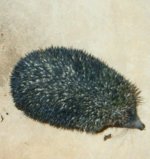 Brandt's Hedgehog
Brandt's Hedgehog (Hemiechinus hypomelas) is a desert hedgehog that belongs to the Erinaceidae family and can be found in Middle Asia and the Middle East. It inhabits desert zones and arid steppes from Iran, Turkmenistan, and even farther eastwards to the region of Tashkent in Uzbekistan down to northern Pakistan and Indus River. It can also be found in Oman and in some islands off Persian Gulf. They prefer natural shelter, but it also resorts to digging and building dens when the need arises. On colder weather, it retires to
hibernate.
Brandt's Hedgehog has a head and body measurement of about 25 centimeters and a weight of approximately 500 to 1,000 grams. It is perhaps the same in size as a West European hedgehog. However, it can be distinguished from its distant relative by its large ears, which in turn is a trait shared in common with another relative, the Long-eared Hedgehog. Compared to the Long-eared Hedgehog, Brandt's hedgehog runs faster because its needle protection is much lighter and yet more superior. The needle protection is a set of spines of hollow hairs that were stiff due to keratin. Unlike the porcupine's quills, a hedgehog's spines cannot be plucked easily off the skin as they are used for defense mechanism. When threatened, a hedgehog can roll itself inward to form a tight ball while the spines protrude outward to serve as spikes.
However, in the vast desert, the Brandt's hedgehog has evolved to use quick running as another mode of defense. It has five short-nailed toes on each of its two front paws. However, its back paws have four toes each with nails that constantly grow long. This serves burrowing purposes. Its range of vocal communication include grunts, snuffles, and even squeals.
Interesting fact: A hedgehog, although classified as an insectivore, is almost an omnivore as it feeds on not only insects but also snails, snakes, toads, frogs, carrion, bird eggs, grass roots, mushrooms, melons, berries, and watermelons.
Photo taken by AshLin, licensed under GFDL
You can help spreading the word about this animal by liking it on facebook
Permanent Link
Saturday 21 April 2007
Bush dog
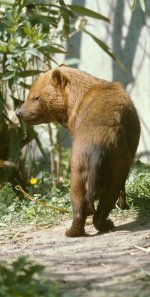
The
bush dog (
Speothos venaticus) can be found from Panama to Argentina. Despite its extensive range, it can seldom be seen and is very rare. It was even thought that bushdogs were extinct, because fossils of the bush dog caused the discovery of the species. Bushdogs are semi-aquatic and can dive underwater with great ease, partly because of their webbed feet. The bushdog's length can range between 57 and 75 centimeters long, and about 30 centimeters in height and weighs around 5 to 7 kilograms. Their biggest threat is habitat destruction, this is because of their low density populations. Bushdogs hunt in packs of 10-12 animals, this helps them bringing down larger prey, like
rheas. Typical prey includes
agouti, pacas and
capybaras.
You can help spreading the word about this animal by liking it on facebook
Permanent Link
Friday 20 April 2007
Eastern avahi
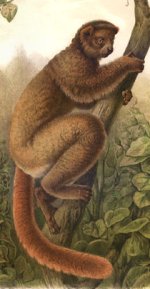
The
Eastern Avahi (
Avahi laniger) is a woolly lemur that lives on Madagascar. They weigh between 600 - 1300 grams and can reach lengths between 30 and 45 centimeters. They belong to the family
Indriidae, which also includes the Indri. The Eastern Avahi is similair to the Indri in feeding behavior, both eat the leaf blade, not the midrib or petiole
. They live in the same areas. This is possible due to the difference in activity times, the Eastern Avahi is nocturnal, while the Indri is diurnal. Avahis mate for life, stay with each other and raise their young as a family. Avahis live in the trees. When on the ground, avahis stand erect and move with their hands in the air just like sifakas. Picture from the book "Planche IX. Alfred Grandidier (1875-1921) In: Histoire physique, naturelle et politique de Madagascar. Volume XX. 1892, Paris: Hachette et Cie."
You can help spreading the word about this animal by liking it on facebook
Permanent Link
Monday 16 April 2007
Golden-mantled ground squirrel
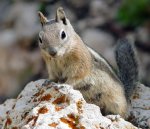
The
Golden-mantled Ground Squirrel (Spermophilus lateralis) is a common and widespread squirrel in North America's forests. It hibernates and stores food in its burrow to have some food when he wakes up. It stores food in its cheeks to run at full speed carrying food back to their burrow. Their territories have a range of about 30 meters around their burrow. Predators of the Golden-mantled Ground Squirrel are birds (hawks and jays), coyotes, weasels, snakes, skunks, foxes and bobcats. Their diet mainly consists of underground funghi and leaves of forbs.
Picture of the Golden-mantled ground squirrel by K.lee, licensed under GFDL
You can help spreading the word about this animal by liking it on facebook
Permanent Link
Friday 13 April 2007
Chital
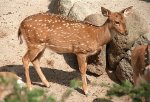
The
Chital (Axis axis) is also known as the spotted deer or the axis deer. It lives in Bangladesh, Sri Lanka and large parts of India. Chitals are the most common species of deer in India. They have also been introduced in Hawaii and Texas. Herds of chital and groups of grey langur share an interesting form of symbiosis. The chital, with their superior sense of smell warn the langurs, and on the other hand, the langurs warn the group of chitals when they spot a predator, such as a tiger, with their keen eyesight. Also, chitals profit from the fruits that the langurs drop.
You can help spreading the word about this animal by liking it on facebook
Permanent Link
Monday 09 April 2007
Eurasian Badger - master of the "sett"
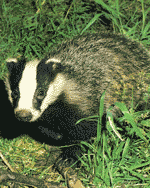
The large underground catacombs in which they live are called "setts".
Badgers (
Meles meles) inherit these setts from their parents, who inherited them from theirs and so forth. It is believed that some setts are actually centuries(!) old. Although studying badgers is difficult, as they mostly live underground, researchers in england excavated a sett to reveal a massive 879 meters of tunnels, 50 chambers, and 178 entrances. They estimated that its construction required the removal of 70 tons of soil! (
source)
You can help spreading the word about this animal by liking it on facebook
Permanent Link
Monday 09 April 2007
Virginia opossum
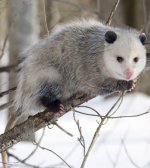
The
Virginia Opossum (Didelphis virginiana) is nocturnal animal, that was introduced in California in 1890, and since then has been very succesful and can be found from Mexico to Canada and from coast to coast throughout North America and appear to be extending their range. They have prehensile tails which can be used to grab branches. The name 'opossum' is sometimes shortened to 'possum', which actually is the name for an Australian group of marsupials. These are distinct from opossums which are only found in North and South America. The Virginia opossum is probably best know for its last resort to escaping predators, "playing possum". As a last resort it can fake death to lose interest of its predator. In the United states, their main threat is getting killed by a car.
Interesting fact: the Virginia Opossum (Didelphis virginiana) is the only marsupial species found in North America.
Picture of the virginia opossum by Cody Pope, licensed under Attribution ShareAlike 2.5
You can help spreading the word about this animal by liking it on facebook
Permanent Link
Friday 06 April 2007
Pygmy rabbit
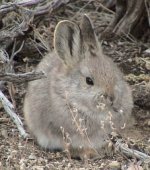
The
Pygmy Rabbit (
Brachylagus idahoensis) is the smallest rabbit species in North America and can easily fit inside one's hand palm. The pygmy rabbit is only one of two rabbits in America which diggs its own burrows and does it extensively, with interconnecting chambers. They can be found at elevations of 1,370 to 2,135 meters (in Nevada) and 1,520 to 1,615 meters (in California). The Pygmy Rabbits' diet consists mainly of sagebrush. Predators of the pygmy rabbit are bobcats, coyotes, weasels, badgers, owls and foxes, but also humans. The IUCN lists the Pygmy rabbit as 'near threatened', certain subspecies are near extinction.
Links
Animal Diversity web on Brachylagus idahoensis
Wikipedia
PacificBio.org on the Washington Pygmy rabbit
You can help spreading the word about this animal by liking it on facebook
Permanent Link
Sunday 01 April 2007
Mountain Gorilla
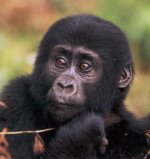 Gorillas
Gorillas (Gorilla gorilla) are the largest living
primates. The Mountain Gorilla (Gorilla beringei) beringei) lives in the Virunga mountains in Africa. The Virunga mountains are a group of vulcanoes in East africa, bordering Uganda, the Democratic Republic of Congo, and Rwanda. Males weigh usually twice as much as females (up to 227 kilograms). There are 380 gorillas in 30 social groups, according to a study done in 2004. They live in groups which consist of the 'silverback', the leader; blackbacks (1 or 2); sexually mature females (3 to 4); and the infants and juveniles (3 to 6). The sizes of the group vary from 5 to 30 animals. Conflicts are often resolved by display which consists of the following steps (from
wikipedia):
The entire sequence has nine steps: (1) hooting slow to fast, (2) symbolic feeding, (3) rising bipedally, (4) throwing vegetation, (5) chest-beating with cupped hands, (6) one leg kick, (7) sideways running, two-legged to four-legged, (8) slapping and tearing vegetation, and (9) thumping the ground with palms to end display (Maple and Hoff 1982). The main threats for the mountain gorilla are war, poaching, human disease, and habitat loss.
Picture by Kurt Ackermann, licensed under Attribution License v. 2.5
You can help spreading the word about this animal by liking it on facebook
Permanent Link
 Brandt's Hedgehog (Hemiechinus hypomelas) is a desert hedgehog that belongs to the Erinaceidae family and can be found in Middle Asia and the Middle East. It inhabits desert zones and arid steppes from Iran, Turkmenistan, and even farther eastwards to the region of Tashkent in Uzbekistan down to northern Pakistan and Indus River. It can also be found in Oman and in some islands off Persian Gulf. They prefer natural shelter, but it also resorts to digging and building dens when the need arises. On colder weather, it retires to hibernate.
Brandt's Hedgehog (Hemiechinus hypomelas) is a desert hedgehog that belongs to the Erinaceidae family and can be found in Middle Asia and the Middle East. It inhabits desert zones and arid steppes from Iran, Turkmenistan, and even farther eastwards to the region of Tashkent in Uzbekistan down to northern Pakistan and Indus River. It can also be found in Oman and in some islands off Persian Gulf. They prefer natural shelter, but it also resorts to digging and building dens when the need arises. On colder weather, it retires to hibernate. 
 The
The  The
The  The
The  The
The  The large underground catacombs in which they live are called "setts".
The large underground catacombs in which they live are called "setts".  The
The  The
The 